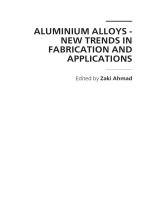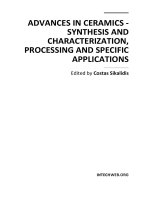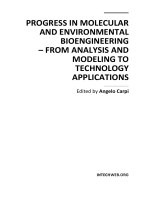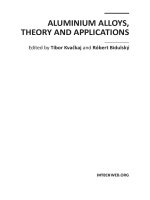ALUMINIUM ALLOYS, THEORY AND APPLICATIONS_1 ppsx
Bạn đang xem bản rút gọn của tài liệu. Xem và tải ngay bản đầy đủ của tài liệu tại đây (23.08 MB, 192 trang )
ALUMINIUM ALLOYS,
THEORY AND APPLICATIONS
Edited by Tibor Kvačkaj and Róbert Bidulský
Aluminium Alloys, Theory and Applications
Edited by Tibor Kvačkaj and Róbert Bidulský
Published by InTech
Janeza Trdine 9, 51000 Rijeka, Croatia
Copyright © 2011 InTech
All chapters are Open Access articles distributed under the Creative Commons
Non Commercial Share Alike Attribution 3.0 license, which permits to copy,
distribute, transmit, and adapt the work in any medium, so long as the original
work is properly cited. After this work has been published by InTech, authors
have the right to republish it, in whole or part, in any publication of which they
are the author, and to make other personal use of the work. Any republication,
referencing or personal use of the work must explicitly identify the original source.
Statements and opinions expressed in the chapters are these of the individual contributors
and not necessarily those of the editors or publisher. No responsibility is accepted
for the accuracy of information contained in the published articles. The publisher
assumes no responsibility for any damage or injury to persons or property arising out
of the use of any materials, instructions, methods or ideas contained in the book.
Publishing Process Manager Ana Nikolic
Technical Editor Teodora Smiljanic
Cover Designer Martina Sirotic
Image Copyright J. Helgason, 2010. Used under license from Shutterstock.com
First published February, 2011
Printed in India
A free online edition of this book is available at www.intechopen.com
Additional hard copies can be obtained from
Aluminium Alloys, Theory and Applications, Edited by Tibor Kvačkaj and Róbert Bidulský
p. cm.
ISBN 978-953-307-244-9
free online editions of InTech
Books and Journals can be found at
www.intechopen.com
Part 1
Chapter 1
Chapter 2
Chapter 3
Part 2
Chapter 4
Chapter 5
Chapter 6
Preface IX
Severe Plastic Deformation and Modelling 1
Effect of Severe Plastic Deformation
on the Properties and Structural Developments
of High Purity Al and Al-Cu-Mg-Zr Aluminium Alloy 3
Tibor Kvačkaj, Jana Bidulská, Robert Kočiško and Róbert Bidulský
An Evaluation of Severe Plastic Deformation
on the Porosity Characteristics of Powder Metallurgy
Aluminium Alloys Al-Mg-Si-Cu-Fe and Al-Zn-Mg-Cu 27
Róbert Bidulský, Marco Actis Grande
Jana Bidulská, Róbert Kočiško and Tibor Kvačkaj
An Anisotropic Behaviour Analysis of AA2024 Aluminium
Alloy Undergoing Large Plastic Deformations 49
Adinel Gavrus and Henri Francillette
Welding Phenomena 69
A Simple Approach to the Study
of the Ageing Behaviour of Laser Beam and Friction
Stir Welds between Similar and Dissimilar Alloys 71
Claudio Badini, Claudia Milena Vega Bolivar, Andrea Antonini,
Sara Biamino, Paolo Fino, Diego Giovanni Manfredi,
Elisa Paola Ambrosio, Francesco Acerra,
Giuseppe Campanile and Matteo Pavese
Non-Destructive Testing Techniques
for Detecting Imperfections
in Friction Stir Welds of Aluminium Alloys 93
Pedro Vilaça and Telmo G. Santos
Aluminium 7020 Alloy
and Its Welding Fatigue Behaviour 115
Carlos Bloem, Maria Salvador, Vicente Amigó and Mary Vergara
Contents
Contents
VI
Fatigue Behaviour of Welded Joints Made
of 6061-T651 Aluminium Alloy 135
Alfredo S. Ribeiro and Abílio M.P. de Jesus
Inhomogeneous Material Modelling
and Characterization for Aluminium
Alloys and Welded Joints 157
Jisen QIAO and Wenyan WANG
Fatigue, Fracture and Cyclic Deformation Behaviour 181
Cyclic Deformation Behaviour and Its
Optimization at Elevated Temperature 183
Patiphan Juijerm and Igor Altenberger
Summary on Uniaxial Ratchetting
of 6061-T6 Aluminium Alloy 199
Guozheng Kang, Jun Ding and Yujie Liu
Crack Growth in AlCu4Mg1 Alloy
under Combined Cyclic Bending and Torsion 217
Dariusz Rozumek and Ewald Macha
Fatigue Crack Growth Simulation
of Aluminium Alloy under Cyclic Sequence Effects 237
S. Abdullah, S. M. Beden and A. K. Ariffin
Creep and Creep-Fatigue
Crack Growth in Aluminium Alloys 259
Gilbert Hénaff, Grégory Odemer and Bertrand Journet
Microstructure Phenomena 283
New Approaches to Reaction Kinetics
during Molten Aluminium Refining
Using Electron Backscatter Diffraction (EBSD) 285
Alfredo Flores and Jesús Torres
Modelling of Precipitation Hardening
in Casting Aluminium Alloys 307
Linda Wu and W. George Ferguson
Metallographic Etching of Aluminium
and Its Alloys for Restoration of Obliterated Marks
in Forensic Science Practice and Investigations 331
R. Kuppuswamy
Chapter 7
Chapter 8
Part 3
Chapter 9
Chapter 10
Chapter 11
Chapter 12
Chapter 13
Part 4
Chapter 14
Chapter 15
Chapter 16
Contents
VII
Machining and Machinability 353
Performance Optimization in Machining of Aluminium
Alloys for Moulds Production: HSM and EDM 355
Andrea Gatto, Elena Bassoli and Luca Iuliano
Machining and Machinability of Aluminum Alloys 377
V. Songmene, R. Khettabi, I. Zaghbani, J. Kouam, and A. Djebara
Part 5
Chapter 17
Chapter 18
Pref ac e
Aluminium alloy has taken over as the most popular material for structural com-
ponents in engineering industry included automotive, aerospace and construction
industries for several reasons. The most characteristic properties of aluminium are
low specifi c weight and low melting point. In addition, aluminium has excellent
corrosion resistance, high strength and stiff ness to weight ratio, good formability,
weldability, high electrical and heat conductivity. Last but not least, aluminium al-
loy components are particularly required for environmental, ecological and eco-
nomical aspects.
The book provides a theoretical and a practical understanding of the metallurgical
principles in: severe plastic deformation processes with respect to high strength and
ductility achieved on bulk and PM aluminium and aluminium alloys; welding of
aluminium, mainly focused on a relatively new technique of friction stir welding
as well as welded fatigue behaviour; cyclic deformation behaviour of the alumini-
um alloys at room and elevated temperature forcefully on the load sequence eff ects
in fatigue crack propagation and crack growth under loading; creep-fatigue crack
growth; modelling of precipitation hardening in casting aluminium alloys; an aniso-
tropic behaviour analysis undergoing large plastic deformations; new approaches to
reaction kinetics during molten aluminium refi ning using electron backsca er dif-
fraction; theoretical explanation about number restoration and etching techniques
applied to recover the obliterated markings on aluminium and aluminium alloys
and information about machining and machinability of aluminium alloys.
Out of all, aluminium alloys off er opportunities in a wide range of applications.
The present book enhances in detail the scope and objective of various develop-
mental activities of the aluminium alloys. A lot of research on aluminium alloys
has been performed. Currently, the research eff orts are connected to the relatively
new methodics and processes. We hope that people new to the aluminium alloys
investigation will fi nd this book to be of assistance for the industry and university
fi elds enabling them to keep up-to-date with the latest developments in aluminium
alloys research.
X
Preface
The editors of this book would like to acknowledge the contribution of all both partici-
pants who kindly submi ed their chapters and those who want to share their work,
and the local organization of the managing the book.
Prof. Tibor Kvačkaj
Technical University of Kosice, Faculty of Metallurgy,
Department of Metals Forming,
Slovakia
Dr. Róbert Bidulský
Politecnico di Torino – Sede di Alessandria,
Italy
Part 1
Severe Plastic Deformation and Modelling
1
Effect of Severe Plastic Deformation on the
Properties and Structural Developments of High
Purity Al and Al-Cu-Mg-Zr Aluminium Alloy
Tibor Kvačkaj
1
, Jana Bidulská
1
, Robert Kočiško
1
and Róbert Bidulský
2
1
Technical University of Kosice, Faculty of Metallurgy, Department of Metals Forming
2
Politecnico di Torino – Sede di Alessandria
1
Slovakia
2
Italy
1. Introduction
Demands of industry producers are to find new forms and facilities for appropriate
properties of structural parts suitable for different miscellaneous structural applications in
the civil, automotive and aircraft industries. With respect to these facts, aluminium alloys
find a wide variety of uses due to their remarkable combination of characteristics such as the
low density, the high corrosion resistance, high strength, easy workability and high
electrical and heat conductivity.
The traditional process is to obtain the improvement in the mechanical properties of
aluminium alloys through the precipitation of a finely dispersed second phase in the matrix.
This is accomplished by a solution treatment of the material at a high temperature, followed
by quenching. The second phase is then precipitated at room or elevated temperatures. For
aluminium alloys this procedure is usually referred to as age hardening and it is also known
as precipitation hardening (Michna et al., 2007); (Mondolfo, 1976). Conventional forming
methods are ineffective in the achieving of favourable properties area of produced parts,
adequate to structural properties; moreover through them only limited levels of structural
and strength-plastic characteristics can be obtained. The solution may be non-conventional
forming methods (Kvačkaj et al., 2005), (Kvačkaj et al., 2004), (Kvačkaj et al., 2010 a) as well
as Severe Plastic Deformation (SPD), such as more preferable are equal channel angular
pressing - ECAP, (Valiev & Langdon, 2006), (Valiev et al., 2000) to obtain results structured
at the nm level. A combination of high strength and ductility of ultrafine polycrystalline
metals, prepared by SPD, is unique and it indeed represents interesting cases from the point
of view of mechanical properties (Chuvil’deev et al, 2008); (Zehetbauer et al., 2006); (Han et
al., 2005) ;(Ovid'ko, 2005); (Meyers et al., 2006); (Kopylov & Chuvil’deev, 2006); (Zehetbauer
& Estrin, 2009). In the past decade, the research focused on to strengthen Al alloys without
any ageing treatment, via SPD (Kvačkaj et al., 2010 b).
The finite element method (FEM) is a proven and reliable technique for analyzing various
forming processes (Kvačkaj et al., 2007); (Kočiško et al., 2009); (Li et al., 2004); (Leo et al.,
2007); (Cerri et al., 2009), (Figueiredo et al., 2006); (Mahallawy et al., 2010); (Yoon & Kim,
2008), in order to analyze the global and local deformation response of the workpiece with
Aluminium Alloys, Theory and Applications
4
nonlinear conditions of boundary, loading and material properties, to compare the effects of
various parameters, and to search for optimum process conditions for a given material
(Kim, 2001).
The unique mechanical properties of the ECAPed material are directly affected by plastic
deformation. Hence, the understanding the development of strain during processing has a
key role for a successful ECAP process. It is well known that the main factors affecting the
corner gap formation during ECAP are materials strain hardening and friction. Thus,
character of the strained condition and uniformity of plastic flow during ECAP is very
sensitive to friction coefficient (Balasundar & Raghu, 2010); (Zhernakov et al., 2001);
(Medeiros et al., 2008).
In order to understand various processes like as the workpiece (billet), die design, the
friction conditions, etc.; it is essential to combine experimental research with a theoretical
analysis of inhomogeneous deformation behaviour in the workpiece during the process.
In addition to the aforementioned properties, the most important factor affecting the
mathematical simulation of material is the stress-strain curve (stress-strain curve influences
the calculation precision). These data can be derived either from database program or from
experimental achieved stress-strain curve. Experimental stress-strain curve can easily be
determined by laboratory tests of formability. The most frequently used formability tests are
torsion and tension (Pernis et al., 2009); (Kováčová et al., 2010).
Structure investigations by TEM analysis will be useful key to identifications and
confirmations the various theories about the material behaviour during the ECAP
processing (Dutkiewicz et al., 2009); (Dobatkin et al., 2006); (Lityńska-Dobrzyńska et al.,
2010); (Maziarz et al., 2010); (Alexandrov et al., 2005).
The present chapter book focused on the effect of Severe Plastic Deformation on the
properties and structural developments of high purity aluminium and Al-Cu-Mg-Zr
aluminium alloy.
Former part deals with the high purity aluminium (99,999 % Al) processed by six ECAP
passes in room temperature. Influence of strain level, strength, microhardness, plasticity and
diameter of grain size in dependence on ECAP passes were investigated. FEM analysis with
respect to influence friction coefficient (f=0,01-0,3) and characteristic of deformed materials
as such materials with linear and nonlinear strengthening on homogeneity of effective
deformations during sample cross section were observed.
Latter part deals with the tensile properties as function of the processing conditions of the
Al-Cu-Mg-Zr aluminium alloy. Based on the results above, the tensile properties, hardness
and structure development of the Al-Cu-Mg-Zr aluminium alloy along with the numerical
simulation are discussed.
2. Experimental conditions
2.1 Experimental conditions for investigation of high purity Al (99,999%Al)
Experimental material was prepared by zonal refining. Structure after producing was
heterogeneous with average grain size d
g
~ 650 μm. Mechanical properties before ECAP
processing are given in Table 1.
The ECAP process was carried out at room temperature by route C (sample rotation around
axis about 180° after each pass) in an ECAP die with channels angle Φ = 90°. The rod-shaped
samples (d
0
= 10 mm, l
0
= 80 mm) were extruded twelve ECAP passages at rate of 1 mm·s
-1
.
The deformation forces during ECAP sample processing was measured using tensometric
measurement with LabVIEW apparatus.
Effect of Severe Plastic Deformation on the Properties and
Structural Developments of High Purity Al and Al-Cu-Mg-Zr Aluminium Alloy
5
0,2%YS [MPa]UTS [MPa] El. [%] HV10[-]
36 52 27 24,2
Table 1. Initial mechanical properties of high purity aluminium (99,999 %)
The static tensile test on the short specimens d
0
x l
0
= 5 x 10 mm was performed. Tensile test
was done after every second ECAP pass on ZWICK 1387 equipment by standard conditions
EN 10002-1. Subsequently, characteristics of the strength (yield strength: YS; ultimate tensile
strength: UTS) and elongation (El.) were determined.
The microhardness test was done on polished surface in longitudinal direction of sample
after every second ECAP pass on LECO LM 700 AT equipment.
Transmission electron microscopy (TEM) analysis with electron diffraction in longitudinal
direction of sample was done on thin foils on Philips CM 20 microscope. The thin foils were
prepared using a solution of 5 % HF at a temperature -25 °C and the time 20 - 30 s.
Material flow in ECAP die was investigated. The samples were longitudinal cutting by wire
cutter. Cutting surfaces were processing by metallographic grinding and polishing.
Polishing surfaces were mechanically marked by square net as is given in Fig. 1. The size of
one element was 1 x 1 mm. The samples after marking were again to join together and put in
to ECAP unit. Orientation of sample cutting plane was identical with the plane lying in
horizontal and vertical cannel axes. One pass in ECAP unit at rate 1 mm·s
-1
was performed.
Fig. 1. Sample preparation before ECAP a) scheme of square net implementation on
polishing surfaces, b) real Al sample with square net
Simulation of ECAP pass was carried out using the finite element method (FEM) in software
DEFORM 2D as considering plane strain conditions (Deform Manual, 2003). Die geometries
were directly designed in the software Deform 2D. The parameters were: circle canal of die
with diameter, d
0
=10 mm, length, L=100 mm, die with channels angle, Φ = 90°, outer
radius, R = 5 mm and inner radius, r = 0 mm. The workpiece dimensions were: diameter, d
0
=10 mm and length, l
0
= 80 mm. The processing rate was constant, v = 1 mm·s
-1
. Friction was
superposed to follow Coulomb’s law with friction coefficient f = 0,12. The processing
temperature was 20 °C. The theory at the base of FEM implies that at first, the problem has
to be divided into little sub problems that are easily to be formulated. There over, they must
all be carefully combined and then solved. The manner in which a problem is divided
constituents the so called meshing process. Mesh density refers to the size of elements that
will be generated within an object boundary. The mesh density is primarily based on the
specified total number of elements. Mesh density according to (Kobayashi & Altan, 1989);
(Deform Manual, 2003) is defined by the number of nodes per unit length, generally along
the edge of the object. The mesh density values specify a mesh density ratio between two
regions in the object. Even though the material properties are same, meshing is the most
Aluminium Alloys, Theory and Applications
6
important factor which will influence the finite element simulation results. The mesh size
specifically influences the corner gap formation.
A higher mesh density offers increased accuracy and resolution of geometry, on the other
the time required for the computer to solve the problem increases as number of nodes
increases. An optimal meshing density has to be chosen according to the geometry and size
of object according in (Kvačkaj et al., 2007); (Kočiško et al., 2009); (Li et al., 2004) specimen
with diameter d
0
= 10 mm has been decided using 20 elements along the width. Hence, the
specimen with diameter d
0
= 10 mm and length l
0
= 80 mm was meshed with 3000 elements,
that’s to say 28 elements on the specimen diameter, as shown in Fig. 2.
Fig. 2. FEM simulation scheme of ECAP
The finer meshes were built close to the surface in order to better match the geometry of the
process, for example in channel areas. Authors (Semiatin et al., 2000) showed that the influence
of channel angles of ECAP equipment was influencing the development of effective strain.
Thus the highest effective strain is achieved if the angle between channels is 90°.
The tools of ECAP equipment (the die and plunger) were assumed to be elastic materials
and they were assigned of tool steel material characteristic, them being much higher than
those of deformed material. The specimen was assumed as elasto-plastic object with their
material characteristics characterized by stress-strain curve Fig. 3.
50
150
250
350
450
00,511,5
Strain [-]
Flow Stress [MPa]
Fig. 3. Stress-strain curve of Al material
Effect of Severe Plastic Deformation on the Properties and
Structural Developments of High Purity Al and Al-Cu-Mg-Zr Aluminium Alloy
7
2.2 Experimental conditions for investigation of Al-Cu-Mg-Zr aluminium alloy
The material used in this experiment was Al-Cu-Mg-Zr aluminium alloy. The chemical
composition is presented in Table 2.
Al Cu Mg Mn Si Fe Zr Ti
balance 4,32 0,49 0,77 0,68 0,23 0,12 0,03
Table 2. Chemical compositions (wt. %) of investigated aluminium alloys
Hot rolling was carried out by rolling-mill DUO 210 at temperature of 460 °C (as-rolled
state). Solution annealing after rolling was performed at temperature of 520 °C (holding
time 9 000 s) and cooled to the room temperature by water quenching (quenched state). The
quenched specimens (d
0
= 10 mm, l
0
= 70 mm) were subjected to deformation in an ECAP
die with channels angle Φ = 90° at rate of 1 mm·s
-1
(ECAPed state). The ECAP was realized
by hydraulic equipment at room temperature. After one ECAP pass, the specimens were
processed to artificial ageing at 100 °C for 720 000 s (ECAPed + aged state).
Tensile specimens were taken after each processing treatments. The tensile testing was done
on a FP 100/1 machine with 0,15 mm·min
-1
cross-head speed (strain rate of 2,5·10
-4
s
-1
). Static
tensile test on the short specimens d
0
x l
0
= 5 x 10 mm was performed. Subsequently,
characteristics of the strength (YS; UTS), El. and Re. were determined.
For optical microscopy, samples were individually mounted, mechanically polished and
finally etched at room temperature using a mixture of 2 % HF, 3 % HCl, 5 % HNO
3
and 90 %
H
2
O (Keller's Reagent).
TEM analysis was performed on thin foils. The foils for TEM were prepared using a solution
of 25 % HNO
3
and 75 % CH
3
OH at a temperature -30 °C. TEM was conducted at an
accelerating voltage of 200 kV.
Additionally, a fractographic study of the fracture surface of the materials after a
conventional tensile strength test was carried out using SEM JEOL 7000F.
The numerical simulation of ECAP process was similar as is described in capture 2.1. Only
sample length l
0
= 60 mm was changed. The specimen was assumed as elasto-plastic object
with their material characteristics characterized by stress-strain curve (Table 3), Young’s
modulus and thermal properties. Certainly, the simulation conditions of investigated
materials were considered so that the bounds of the deformation strain, strain rate and
deformation temperature can’t lead to loss of accuracy.
Strain [-]
0 0,1 0,2 0,3 1
Database data / stress [MPa]
0 200 233 250 312
Experimental data / stress [MPa]
0 68 144 174 324
Table 3. Stress-strain data of Al-Cu-Mg-Zr aluminium alloy for both conditions
Materials characteristics for both conditions are presented in Table 4.
Hence, mathematical simulations of ECAP process of Al-Cu-Mg-Zr aluminium alloy were
realized on the basis of two approaches for stress-strain curve selection: from DEFORM
material database and from experimental results. The DEFORM material database contains
flow stress data for Al-Cu-Mg-Zr aluminium alloy (Table 3). The flow stress data provided by
the material database has a limited range in terms of temperature range and effective strain.
Aluminium Alloys, Theory and Applications
8
Workpiece Database Experimental
Plastic Flow stress (Table 2)
Young’s modulus [MPa] 68900 70000
Poisson’s ratio [-] 0,33 0,33 Elastic
thermal expansion [K
-1
]
2,2⋅10
-5
2,2⋅10
-5
thermal conductivity [kW/m⋅K]
180,2 180,2
Thermal
heat capacity [kJ·kg
-1
·K
-1
] 2,433 2,433
Damage model (Fracture data) Cockcroft-Latham
Table 4. Materials characteristics for both investigated specimens
3. Results and discussion
3.1 Experimental results and discussion for high purity Al (99,999%Al)
3.1.1 FEM investigation
The deformed net after 1
st
ECAP pass is shown in Fig. 4a. Deformed net on sample surfaces
was scanning and computer cover by new net for better visualisation as is given on Fig. 4b.
Numerical simulations of net deformation in software DEFORM 2D are shown in Fig. 4c.
The intensity of plastic deformation is depended on angle of shearing strain γ. With
increased of shearing strain angle is increasing also intensity of plastic deformation. The net
deformation of sample is pointing out localization of biggest plastic deformation to top
sample part which correspond with inner radius (r) of ECAP channel. The value of this
shearing strain angle is γ = 60°. This value is observing up to 2/3 of sample cross section.
Started from 2/3 of top to bottom sample part shearing strain angle is rapid decreasing up
to level γ = 8°. Reported by authors (Beyerlein et al., 2004); (Stoica et al., 2005) this low level
is characterizing by straining way in deformation zone which is more bending as plastic
flowing. Mutual comparison of shearing strain angles γ obtained from experiment and
numerical simulation reference to high conformity of results. Some difference was observed
only in 1/5 bottom sample part where preferable deformation is bending.
The ECAP channel filling by processing material has influence on distribution of effective
plastic deformation, which depends on: contact friction, stress – strain (σ-ε) curves
characterizing deformed material and geometrical definition of ECAP die (Li et al., 2004).
For numerical simulation of 1
st
ECAP pass geometrical definition of channels was as follow:
Φ = 90°, R = 0 mm and r = 0 mm. The influence of friction coefficient in interval f = 0,01 –
0,25 on channels filling was simulated as is shown in Fig.5.
If geometrical definition of channels (Fig. 6) was describe by formula (1) (Oh et al., 2003) that
linear graphical dependence shown in Fig. 7 was obtained.
.1
h
h
v
d
d
d
λ
⎛⎞
=+
⎜⎟
⎝⎠
(1)
where: λ [-] – index for the outer corner
d
h
[mm] – distance between die corner and horizontal contact point of die
and workpiece
d
v
[mm] – distance between die corner and vertical contact point of die and
workpiece
Effect of Severe Plastic Deformation on the Properties and
Structural Developments of High Purity Al and Al-Cu-Mg-Zr Aluminium Alloy
9
Fig. 4. Deformed net after 1
st
ECAP pass a) Deformed net on real sample, b) Visualisation
deformed net after scanning and computer redrawing with marking of angle of shearing
strain γ, c) Deformed net after numerical simulation in DEFORM 2D
Fig. 5. ECAP channels filling in dependence on friction coefficient: a) f = 0,01; b) f = 0,12;
c) f = 0,18; d) f = 0,25; d) f = 0,3 a e) f = 0,35
From graph is resulting that better channels filling by material were obtained when friction
coefficient was increased. The numerical simulations confirm biggest localization of effective
strain heterogeneity to bottom side of sample as is shown in Fig. 8.
The influence of σ-ε curves characterizing deformed material on channels filling was
numerical simulated for σ-ε curves with linear (Fig. 9) and nonlinear (Fig. 10) strengthening.
The measurement of lengths d
h
and d
v
for both type of σ-ε curves are given in Fig. 11, Fig. 12
and dependence of shape index of outer corner on angle of curves inclination is given in Fig.
13. From graphical dependences is resulting negligible influence of σ-ε strengthening type
curves (linear and nonlinear strengthening) on channels filling for curve types 1-5. If
strengthening curves are approaching to ideal rigid – plastic form with minimal
strengthening (types 6-7) so differences in channel filling are observing.
Aluminium Alloys, Theory and Applications
10
Fig. 6. Geometrical definition of channels
2
3
4
5
6
0 0,1 0,2 0,3 0,4
Friction coefficient f [-]
λ=d
h
(1+(d
h
/d
v
)) [-]
Fig. 7. Dependence of index of outer corner shape on friction coefficient
0,4
0,6
0,8
1
1,2
1,4
0246810
Distance from bottom to top sample [mm]
Strain - Effective [-]
f = 0,35 f = 0,3
f = 0,25 f = 0,18
f = 0,12 f = 0,01
Fig. 8. Distribution of effective strain φ
ef
in cross section sample on friction coefficient
Effect of Severe Plastic Deformation on the Properties and
Structural Developments of High Purity Al and Al-Cu-Mg-Zr Aluminium Alloy
11
50
150
250
350
0 0,4 0,8 1,2
Strain [-]
Flow Stress [MPa]
type 1
type 2
type 3
type 4
type 5
type 6
type 7
Fig. 9. The σ - ε curves with linear strengthening
50
150
250
350
450
550
00,40,81,2
Srain [-]
Flow Stress [MPa]
type 1
type 2
type 3
type 4
type 5
type 6
Fig. 10. The σ - ε curves with nonlinear strengthening
0
2
4
6
8
10
01234
d
h
[mm]
dv [mm]
type 1
type 2
type 3
type 4
type 5
type 6
type 7
Fig. 11. Effect of σ - ε curves with linear strengthening on the channel outer filling
Aluminium Alloys, Theory and Applications
12
0
2
4
6
8
10
01234
d
h
[mm]
d
v
[mm]
type 1
type 2
type 3
type 4
type 5
type 6
Fig. 12. Effect of σ - ε curves with nonlinear strengthening on the channel outer filling
0
2
4
6
0246
Type of σ-ε curve with linear strengthening
λ=dh(dv+(dh/dv))
σ - φ curve of linear strengthening
σ - φ curve of nonlinear strengthening
Fig. 13. Dependence of index of outer corner shapes on the type of strengthening curve
3.1.2 Mechanical and structural properties after ECAP
The change of mechanical properties in dependence on number of ECAP passes is shown in
Fig. 14. Ultimate tensile strength (UTS) is slightly sensitive on ECAP passes and
substructure formation. Yield strength (0,2% YS) is decreasing up to 6
th
pass where achieved
local minimum. From 6
th
up to 12
th
pass is growing. Elongation to failure (El.) is inversing
to 0,2% YS. Microhardness dependence is given in Fig. 15 from which resulting
microhardness growth with an increase of ECAP passes.
TEM analysis was performed on samples after 4
th
, 6
th
, 8
th
and 12
th
ECAP passes and shown
in Fig. 16 - 20.
Initial structure is creating with large polyedric grains (d
g
~ 650 μm) and low dislocation
density. Cell substructure with subgrain diameter d
sg
~ 2,6 μm was searched after 4
th
and 6
th
ECAP passes and are given in Fig. 17, 18. Dislocations are generated with plastic deformation
and arranged to dislocation walls, which later transform to subgrains with low or high angles,
as it is seeing in Fig. 19. Subgrains are equiaxial with average size d
sg
~ 2,2 μm.
Substructure after 12
th
ECAP pass is equiaxial with low misorientation and average subgrain
size d
sg
~ 1 μm (Fig. 20). Average subgrain size in dependence to number ECAP passes is
given in Fig. 21. The significant substructure refinement was observed after 6
th
ECAP pass.
Yield strength starts to grow also after 6
th
pass, what coincide with strengthening from grain
size refinement after the Hall-Petch equation. Random coarse grains in fine structure matrix
were observed after 4
th
and 12
th
ECAP pass as shown in Fig. 22.
Effect of Severe Plastic Deformation on the Properties and
Structural Developments of High Purity Al and Al-Cu-Mg-Zr Aluminium Alloy
13
0
10
20
30
40
50
60
024681012
No. of ECAP
p
asses
Yield strength - 0.2% YS [MPa]
Ulimate tensile strength - UTS [MPa
]
0
20
40
60
80
100
Elongation A [%
]
UTS 0.2% YS A
Fig. 14. Development of mechanical properties on ECAP passes
22
24
26
28
30
32
024681012
No. of ECAP passes
Microhardness HV 10 [-]
Fig. 15. Microhardness change on ECAP passes
Fig. 16. TEM micrograph before ECAP (d
g
~ 650 μm)









